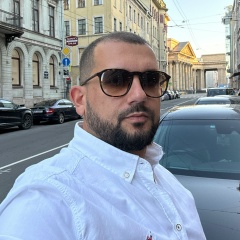Представляете, вчера держала в руках удостоверение личности своего прадеда! По документу, он родился в 1909 году, но бабуля говорит, что в 1907-м, то ли ошиблись, то ли он специально два года урезал себе (например, чтобы в армию не идти или потому что были неграмотными, что вероятнее).
Теперь знаю, что мои предки жили в Посьетском районе Приморского края, в 200 км от Владивостока. Потом прадедушка женился и уехал в Хабаровск. Это спасло его от верной гибели. Бандиты ворвались в дом и зарубили топором почти всю семью: спаслись моя прабабушка и её младшая дочь Таня, забившись под перину. Бабушка умерла через полгода после трагедии, а Таня жизнь прожила и умерла от рака в Гомеле (я её не знала...).
И ещё мне теперь известно настоящее, корейское, имя моего прадеда! Ким Сынзюни. А я всю жизнь думала, что его зовут Михаил. Все гадала, в каком же поколении русские имена начали давать именно в нашей семье)))
Удостоверение в 1928 г. прадеду выдала Посьетская районная рабоче-крестьянская милиция посёлка Славянка. Посёлок (сейчас пгт) Славянка впервые упоминается в 1861 г., а за год до этого - как официально считается - начинается переселение корейцев в Россию (недавно как раз отмечали 150-летие). Создание военных постов Новгородского (впоследствии Посьета) и Славянки связано с тем, что Александр II после проигранной Крымской войны меняет направление внешней политики и реализует план о присоединении к России Амурского края.
Вот было бы здорово туда попасть. Погулять по земле, по которой ходили мои предки...
Теперь знаю, что мои предки жили в Посьетском районе Приморского края, в 200 км от Владивостока. Потом прадедушка женился и уехал в Хабаровск. Это спасло его от верной гибели. Бандиты ворвались в дом и зарубили топором почти всю семью: спаслись моя прабабушка и её младшая дочь Таня, забившись под перину. Бабушка умерла через полгода после трагедии, а Таня жизнь прожила и умерла от рака в Гомеле (я её не знала...).
И ещё мне теперь известно настоящее, корейское, имя моего прадеда! Ким Сынзюни. А я всю жизнь думала, что его зовут Михаил. Все гадала, в каком же поколении русские имена начали давать именно в нашей семье)))
Удостоверение в 1928 г. прадеду выдала Посьетская районная рабоче-крестьянская милиция посёлка Славянка. Посёлок (сейчас пгт) Славянка впервые упоминается в 1861 г., а за год до этого - как официально считается - начинается переселение корейцев в Россию (недавно как раз отмечали 150-летие). Создание военных постов Новгородского (впоследствии Посьета) и Славянки связано с тем, что Александр II после проигранной Крымской войны меняет направление внешней политики и реализует план о присоединении к России Амурского края.
Вот было бы здорово туда попасть. Погулять по земле, по которой ходили мои предки...
Imagine yesterday I was holding in my hands the identity card of my great-grandfather! According to the document, he was born in 1909, but granny says that in 1907, they were either mistaken, or he specially cut off for himself two years (for example, to not join the army or because they were illiterate, which is more likely).
Now I know that my ancestors lived in the Posyetsky district of the Primorsky Territory, 200 km from Vladivostok. Then the great-grandfather got married and left for Khabarovsk. This saved him from certain death. The bandits broke into the house and killed almost the whole family with an ax: my great-grandmother and her youngest daughter Tanya escaped, hiding under the feather bed. Grandmother died six months after the tragedy, and Tanya lived and died of cancer in Gomel (I did not know her ...).
And now I know the real, Korean, name of my great-grandfather! Kim Sungun. And all my life I thought that his name was Michael. I wondered in what generation Russian names began to be given precisely in our family)))
The certificate in 1928 was issued to the great-grandfather by the Posyetsky district workers and peasants militia of the village of Slavyanka. The village (now a town) of Slavyanka was first mentioned in 1861, and the year before - as is officially believed - the resettlement of Koreans to Russia begins (the 150th anniversary was recently celebrated). The establishment of the military posts of Novgorod (later Posyet) and Slavyanka is due to the fact that Alexander II, after the lost Crimean War, changes the direction of foreign policy and implements the plan to join the Amur Territory to Russia.
That would be great to get there. Take a walk on the ground on which my ancestors walked ...
Now I know that my ancestors lived in the Posyetsky district of the Primorsky Territory, 200 km from Vladivostok. Then the great-grandfather got married and left for Khabarovsk. This saved him from certain death. The bandits broke into the house and killed almost the whole family with an ax: my great-grandmother and her youngest daughter Tanya escaped, hiding under the feather bed. Grandmother died six months after the tragedy, and Tanya lived and died of cancer in Gomel (I did not know her ...).
And now I know the real, Korean, name of my great-grandfather! Kim Sungun. And all my life I thought that his name was Michael. I wondered in what generation Russian names began to be given precisely in our family)))
The certificate in 1928 was issued to the great-grandfather by the Posyetsky district workers and peasants militia of the village of Slavyanka. The village (now a town) of Slavyanka was first mentioned in 1861, and the year before - as is officially believed - the resettlement of Koreans to Russia begins (the 150th anniversary was recently celebrated). The establishment of the military posts of Novgorod (later Posyet) and Slavyanka is due to the fact that Alexander II, after the lost Crimean War, changes the direction of foreign policy and implements the plan to join the Amur Territory to Russia.
That would be great to get there. Take a walk on the ground on which my ancestors walked ...
У записи 16 лайков,
1 репостов.
1 репостов.
Эту запись оставил(а) на своей стене Алла Хегай





































